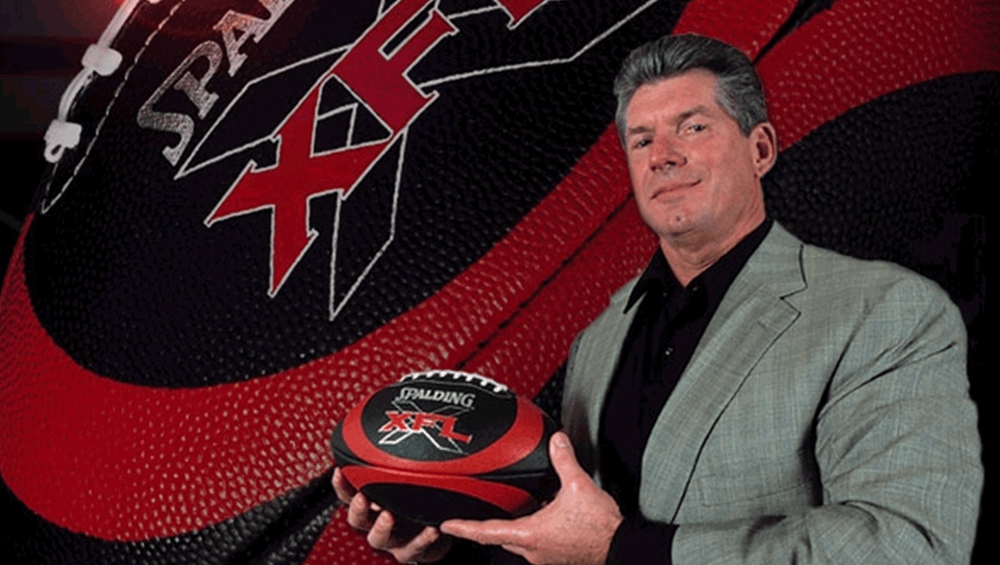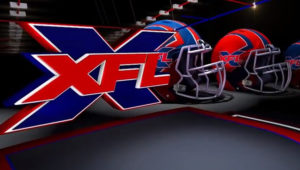
TVN Focus | Ad Buyers See An Opening For McMahon’s XFL

After nearly two decades in pro football limbo, WWE’s Vince McMahon is resurrecting the XFL next spring with eight teams and a 10-week TV schedule on ABC, Fox and their companion cable networks that picks up where the NFL leaves off after the Super Bowl.
And media buyers seem willing to give the league another chance.
“The XFL has a good chance to become a small, viable opportunity for clients based on its WWE ownership backing,” says Adam Schwartz, SVP and director of sports buying at Horizon Media.
“I don’t think the XFL will ever become the NFL, but if the product is strong, it will get viewers to watch and perhaps, to gamble on the games [and] that will draw more viewer interest.”
Sports gambling is now legal in 13 states, with New Jersey starting to make a run at sports gambling dollar leader Nevada.
Neil Vendetti, president of investment at Zenith USA, is also game. “With the amount of interest in the NFL only increasing, there is potentially an opportunity for the XFL.”
Vendetti points to the Alliance of American Football, a spring league similar to the XFL that that folded this year after only eight weeks of its scheduled 10-week season due to financial problems. It showed that some people aren’t done with football just because the NFL season ends, he says. “The AAF had a good product on the field and the ratings weren’t horrible.”
Gibbs Haljun, managing director, media investment at GroupM, says the XFL could “potentially be successful.” Since many of the telecasts will be on Saturday and Sunday afternoons in February through April, he says, time will be cheap and that could motivate some advertisers to jump in. “It’s going to be low risk for advertisers.”
 Despite the interest, the buyers caution that it is early days and that whether they buy and how much they buy will depend on how the team rosters come together and how the time is priced. The networks that will be televising the games — ABC/ESPN/ESPN2 and Fox/FS1/FS2 — have not yet begun making their pitches. “For us, we need a better handle on what’s happening,” adds GroupM’s Haljun.
Despite the interest, the buyers caution that it is early days and that whether they buy and how much they buy will depend on how the team rosters come together and how the time is priced. The networks that will be televising the games — ABC/ESPN/ESPN2 and Fox/FS1/FS2 — have not yet begun making their pitches. “For us, we need a better handle on what’s happening,” adds GroupM’s Haljun.
The buyers say the selling could start in mid-to-late October after the XFL holds its draft and rosters of the teams are set.
While matchups are yet to be announced, the season opener will be televised by ABC at 2 p.m. on Saturday, Feb. 8, 2020, followed by a second game at 5 p.m. on Fox.
In total, the networks will televise the XFL’s entire 40-game regular season schedule, along with two post-season semifinal games and the championship game.
ABC will televise 13 games, Fox 10, FSI nine, ESPN five, ESPN2 two and FS2 one. ESPN and Fox will each televise a semifinal game, and ESPN will televise the XFL Championship Game at 3 p.m. on Sunday, April 26.
Most of the games will be televised on Saturdays and Sundays, with early games beginning at 2 p.m., and later games at either 6 or 7 p.m. Fox will also televise two games in primetime — in weeks nine and 10 of the season — at 8 p.m.
The eight charter teams: Dallas Renegades, Houston Roughnecks, Los Angeles Wildcats, New York Guardians, St. Louis Battlehawks, Seattle Dragons, Tampa Bay Vipers and Washington, D.C. Defenders.
The XFL is going to operate like the AAF in that one entity owns all the teams. However, the arrangements under which the networks will be televising the games will be different. The AAF paid the networks — CBS, Turner and The NFL Network — to televise its games and sold its own advertising, similar to a time buy.
By contrast, the XFL has granted the networks the TV rights. It up to the networks to cover the production costs and sell the ad inventory. The networks will keep all that they sell. The XFL expects to make money from corporate sponsorships and from selling tickets to the games and XFL merchandise.
The league will have deeper financial pockets than the AAF did. McMahon reportedly has $500 million to invest in the new XFL, with about $270 million of that coming from his selling of some of his WWE stock.
While neither Fox nor Disney on behalf of ABC/ESPN would discuss specifics of potential pricing of commercials or the timing of when sales will start, they are positive about being able to sell the inventory.
“We will go to market when we feel the timing is right,” says Seth Winter, executive VP of sports sales at Fox. “We believe in the XFL and what it will bring to the market. I think people will be very surprised. It will be a very competitive product, ratings-wise.”
That’s certainly not in comparison to the NFL which averaged about 15 million viewers across all its TV partners last season, but possibly in comparison to other programming that would fill the time periods.
The opening night AAF game in February on a Saturday night in primetime on CBS drew 2.9 million viewers, a solid number for the lowest-watched night of the week on broadcast television.
That game actually drew a higher household rating — a 2.1 — than an NBA telecast at the same time on ABC, which scored a 2.0. And it also outdrew viewership on the other broadcast networks for the night.
Jordan Schlachter, chief marketing officer at the XFL, says the potential audience to watch professional football following the NFL season is there. It will just be a matter of tapping into it.
“There are a tremendous number of football fans looking to watch more football in the spring once the Super Bowl is over,” says Schlachter, who prior to joining the XFL, was CMO of the NBA Players Association.
“We are not competing with the NFL,” Schlachter adds. “We are trying to target football fans to watch our games, and there are 38 million football fans who say they want to watch more football after the Super Bowl. We are targeting those passionate fans and giving them another football option after the NFL season ends.”
Schlachter says the XFL has “put a lot of work and research into determining who our target audience is and we are sharing that with the networks.”
He says the XFL will be working with the networks’ sales staffs on ways to integrate advertisers into the telecasts beyond traditional commercial breaks.
“We’re open to innovative integrations during the telecasts and hope there will be a lot of integrations that can be offered to advertisers,” Schlachter says.
In addition to triggering time selling, the setting of the rosters will also allow the XFL and its network partners to begin promoting the league.
Fox is airing the Super Bowl this year and sources within Fox say the network will more than likely promote the XFL during the game.
The original XFL, a joint venture with NBC in 2001, will make its return this spring in a far different TV environment than the one that it left 18 years ago after just one season.
Its opening night game on a Saturday night on NBC in 2001 drew a household rating of 9.5, but that was the high point of the season.
The rest of the games on NBC during the season averaged a 3.0, while games on UPN and TNN averaged household ratings of 1.3 and 0.8 respectively. And by the last week of the season, NBC was averaging only a 1.5 and the household rating for the championship game was 2.1.
Advertisers initially paid about $140,000 for 30-second spots on NBC, according to reports back then, but as ratings fell, scatter pricing for each ad fell to around $60,000. And still, makegoods were paid out to advertisers.
As the season went along, only about 63% of the ad inventory across the three networks was sold, and, by the time the season ended, about a third of all commercials airing were the result of makegoods or network paybacks for underdelivery.
Among the advertisers in the 2001 XFL telecasts were Burger King, AT&T, Anheuser-Busch, Miller, M&M Mars, Gillette, Spalding, Honda, Penzoil, Quaker State, Pep Boys, Castrol, Sony Pictures, Warner Bros., Universal Pictures, 20th Century Fox, New Line Cinemas and the U.S. Army.
McMahon and NBC invested about $100 million in the 2001 XFL season and each wound up losing another $35 million on top of that, according to reports at the time.
Media buyers say if Fox and ABC/ESPN have trouble selling XFL ad units separately, they each have enough spring sports to sell XFL ads as part of multi-sport packages. In the case of ESPN, XFL ads can be moved as part of run of schedule packages.
The XFL’s Schlachter is, of course, confident that it will all come together. “We have a very strong business model and solid business partners in Fox and ABC/ESPN and our TV schedule is different than the AAF. We couldn’t be more thrilled that fans are going to be able to find the XFL on TV in places they are used to seeing football like Saturday evenings and two Thursday nights on Fox.”


































Comments (1)
Fran says:
September 12, 2019 at 5:12 pm
This site basically plagiarized your story
https://www.xflnewshub.com/xfl-news/ad-buyers-opportunity-with-xfl/?fbclid=IwAR2jlG-rIMl-l9_IICtG5E06RcFPq7SNE5cW0uqedw2rrgAjdBNT2Dqo5_Q